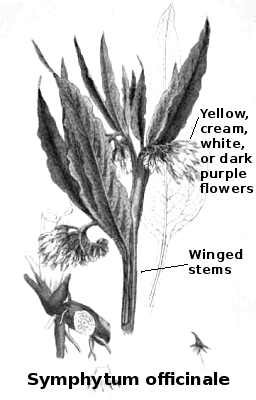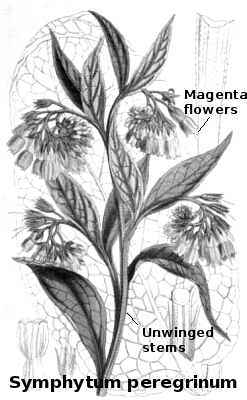
Russian comfrey
 The
primary reason for the mixed reports on comfrey's efficacy stems from a
confusion of terms. Even after reading the entire chapter in
Hills' Russian Comfrey about comfrey species, I had
to do a bit more research to make sure I had the story straight.
The
primary reason for the mixed reports on comfrey's efficacy stems from a
confusion of terms. Even after reading the entire chapter in
Hills' Russian Comfrey about comfrey species, I had
to do a bit more research to make sure I had the story straight.
There appear to be three
comfrey species in cultivation at the moment
(as well as several others growing wild.) The least interesting
from a permaculture point of view is Prickly Comfrey (Symphytum
asperrimum, aka S. asperum.) This comfrey is
easily identified by its sky blue flowers, and is only useful as an
ornamental.
On the other hand,
Common Comfrey (sometimes just called Comfrey, Symphytum
officinale) is
largely cultivated as a
healing herb. The plant usually has winged stems and yellow,
cream, white, or dark purple flowers. Common Comfrey is
relatively easy to confuse with the third species of comfrey, but
yields much less biomass.

Finally, Russian Comfrey
is the star of the permaculture show. To
make it nice and simple, Russian Comfrey has been known by the
following scientific names: S.
peregrinum, S.
officinale x asperrimum, S.
uplandicum, or S.
asperum x officinale.
To cut through the Latin for you, that means that some folks think
Russian Comfrey is a hybrid between the first two comfrey species I
discussed, while others think it merits species status.
The best Russian
Comfreys --- which may not be all of them --- are very
palatable to livestock, have magenta flowers (or perhaps blue flowers
that fade to pink), and have solid, wingless flower stems.
Russian Comfrey can produce up to 120 tons of plant matter per acre per
year, while Common Comfrey clocks in at about a third that.
Although he didn't write
about it in his book, Lawrence Hills apparently
went on to select a super productive Russian Comfrey now known as
"Bocking 14". Since I'm pretty sure that the comfrey I've been
playing with is merely Common Comfrey, I've put "Bocking 14" on my
plant wish list. Anyone out there have a cutting you can spare?
| This post is part of our Comfrey lunchtime series.
Read all of the entries: |
Want more in-depth information? Browse through our books.
Or explore more posts by date or by subject.
About us: Anna Hess and Mark Hamilton spent over a decade living self-sufficiently in the mountains of Virginia before moving north to start over from scratch in the foothills of Ohio. They've experimented with permaculture, no-till gardening, trailersteading, home-based microbusinesses and much more, writing about their adventures in both blogs and books.
Want to be notified when new comments are posted on this page? Click on the RSS button after you add a comment to subscribe to the comment feed, or simply check the box beside "email replies to me" while writing your comment.

Julie --- Thanks so much for the offer! I'm always glad to try another kind of comfrey! Would you like a cutting of our common comfrey (I think is what it is) or Bocking 4 in exchange? (I splurged and bought some of the latter last fall and it's now big enough to be divided.)
I don't think it'll be tough to mail. I'd just wrap the root in a wet newspaper, then in a plastic grocery bag (leaving the leaves unwrapped), and stuff it in a box. Comfrey seems to be hard to kill....
Drop me an email at anna@kitenet.net if you'd like to talk addresses and swaps.